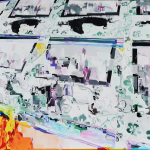BY ALESSANDRA RAENGO [1]
Kara Walker’s installations have garnered international attention since the early 1990s for deploying an archaic representational form of portraiture—the cutout silhouette. They have been the target of considerable controversy[2] for the perceived obscenity of her imagery and the alleged revival of deep-seated racial stereotypes.[3] Controversy that, I contend, is only partly a response to her iconography and more to her medium of choice: life-size black cut-paper figures glued onto the gallery walls. Walker creates forms that maximize what the viewer brings to them. They seemingly prod their way into existence from a state of individual and collective slumber. Thus, Walker occasions a most uncomfortable drift in the history of pre- to post-cinematic representations: the question of where her figures come from is just as disturbing as the question of what they show,[4] and the slippage between the two, I argue, addresses recurring ontological questions within the history and theory of film—namely those regarding the “substance” of cinematic shadows and the dialectic between presence and absence within the imaginary signifier—while recasting them as inseparable from the racialization of the visual.
This chapter argues that Kara Walker is a visual theorist from whom Film Studies has much to learn.[5] First, the way in which her silhouettes explosively mingle the indexical and the iconic orders of signification intervenes in our understanding of two of the most influential paradigms for the cinematic image: the shadow and the mirror. Secondly, despite—and possibly because of—its stillness, her work provides an extended and uncompromising version of the cinematic screen as the meeting point of projection and reflection. Third, it shows how the phenomenology of the film surface supports itself on the phenomenology of the racialized body and thus how “photographic” visuality is never fully innocent of processes of racialization.[6] What shocks about Walker’s work—besides its visualization of a deep complicity in the social relations of slavery; and its portrayal of multiple violations of the body across race, gender and age—is the fact that we recognize these figures all too well: at first iconographically, and secondly because they inhabit several representational modes, spaces, and traditions at once.
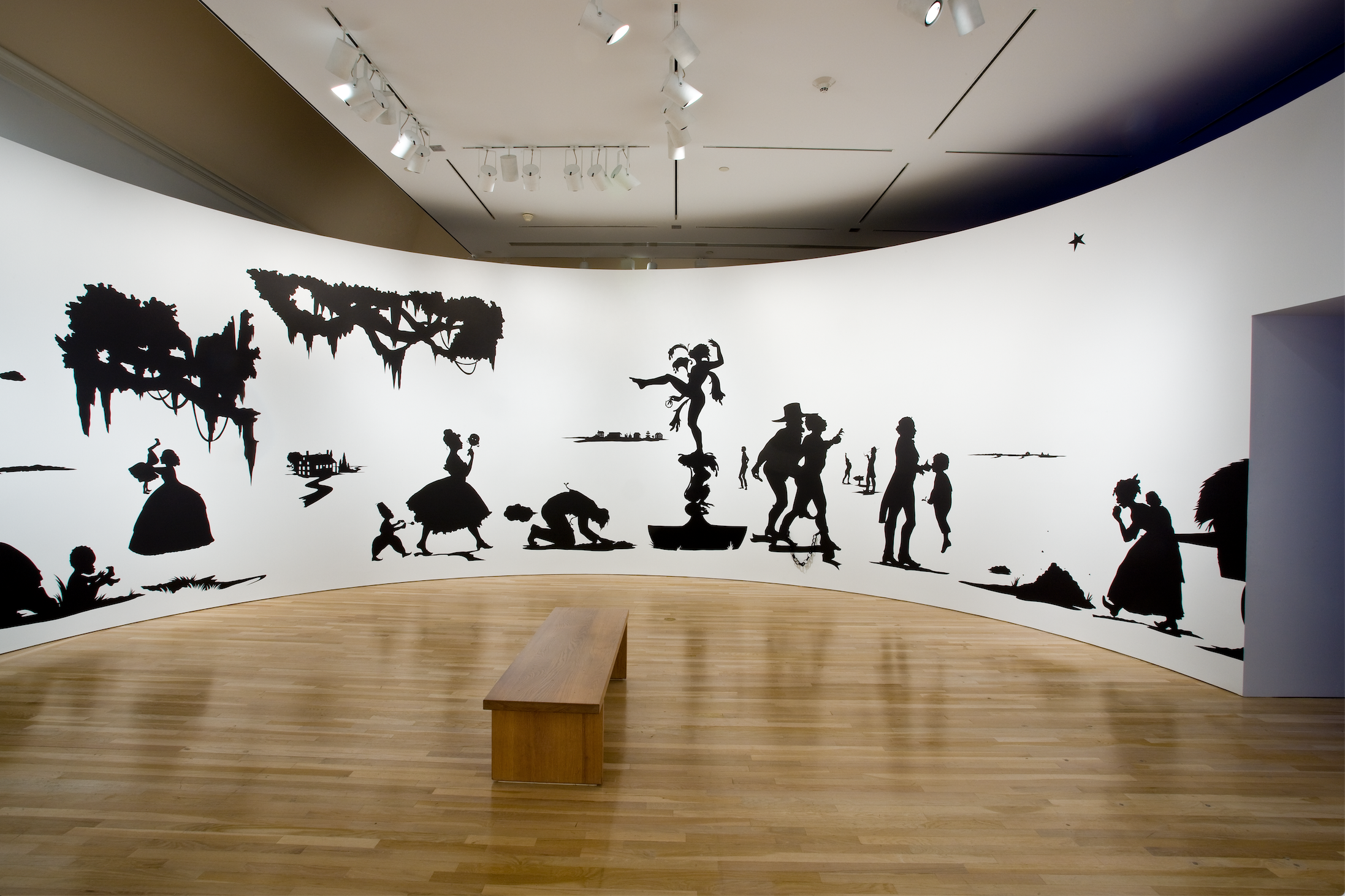
Her installations are arranged in continuous scenes that reproduce the 360-degree space of pre-cinematic spectacles such as the panorama and the diorama and confront the spectator unflinchingly with figures endowed with a sense of absolute presence (Figure 1, above). From a distance, they expound the composed elegance of historical tableaux of plantation life in the antebellum South. Upon closer scrutiny, they reveal not only decisive racial characterizations, but also a commingling of bodies in erotic, sadistic, and masochistic acts (Figure 2, below). These bodies defecate, suck, and ejaculate. They are ecstatic and grotesque, always extending beyond their own boundaries and those of decency. It is this violent collision of the silhouettes’ pristine and abstract forms with the carnality evoked by these bodies’ behaviors and their compulsive penetrations that manifests the double legacy of her figures: bourgeois portraiture, on the one hand, and the racially overdetermined silhouette of the social sciences, on the other.
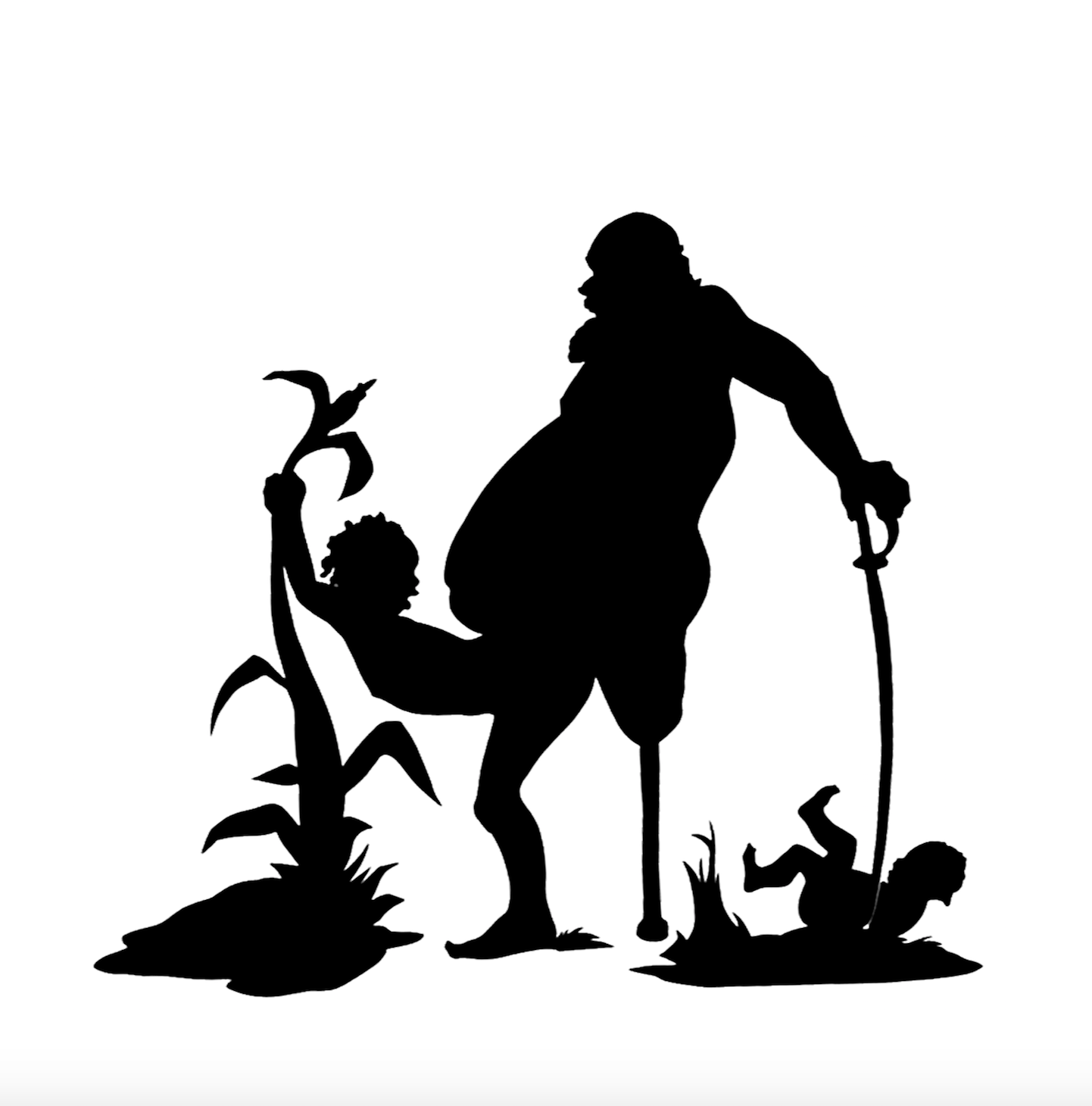
Tellingly, one of the most pressing questions among interpreters of Walker’s work has been how to describe the ontological status of her figures and therefore how to cope with their ambiguous indexicality. This indexicality, as her work makes abundantly clear, extends from a temporal and existential order of signification (i.e. index as the present sign of a past state of affairs; index as the “having-been-there” of the object) to a spatial one, which involves both presence and contiguity. Simply put: what are we looking at? Silhouettes or shadows? We know they are cut paper, but why then do they feel attached to some-body? As I will show, in Walker’s work indexicality entails a spatial theory of relations of identity and difference. Hence, more than a semiotic question, it is also a question of self and other, which is further complicated by tensions existing along other axes as well: the temporal, the existential, the mimetic. Are her figures dead or alive? Fixed or mobile? Are they inventions or citations? Copies or originals? Reflections or projections? A preliminary answer to these questions, I suggest, lies in her chosen medium.
Featured in the mythical origin story of the figurative arts, the first silhouette was produced by a woman—the Maid of Corinth, in Pliny the Elder’s account—in an attempt to preserve the likeness of her departing lover by drawing the outline of his cast shadow.[7] The silhouette is a reified version of the shadow, hence a representational form that registers the transition from an indexical to an iconic order, from a metonymical to a metaphorical function. In fact, while the shadow is a fleeting indexical sign, because it requires the presence of the body that produces it, the silhouette is its human-made, durable reproduction and as such survives the body’s departure. In the silhouette the body has fully vacated the sign—dissolved in the abstract iconicity of its contour—and has left behind a blackness, which is held as the trace of its past presence and current absence. What Derrida calls the “work of mourning” thus lies at the origin of this representational form. In fact, as much as the Corinthian Maid’s fixation brings the image of her lover to life in a material reproduction of his likeness, it also already mourns its model’s death. The silhouette and the cinema share this originary loss and deferral; they are both—as Derrida puts it—“spectralizing technologies”; they are both phantomachias: a play of ghosts; memories of something that has never had the form of presence (qtd. in Schwartz 14).
Just like the cinematic “ghost,” Walker’s silhouettes, as Ann Wagner argues, speak an economic language of substitution and erasure insofar as each figure enlists the viewer’s complicity in investing the black hole of the body’s departure with the sense of metaphysical presence of a portrait (94). Within the bourgeois context of portraiture, in other words, the blackness of the silhouette was not racially coded, but rather functioned fetishistically—that is, as Homi Bhabha has influentially argued, also stereotypically—because the sign of a bodily absence was transfigured into a mark of personhood through sentimental memory and nostalgia.[8] The blackness of the silhouette functioned as both a signifier of emptiness, insofar as it indexes the absence of the body, and of fullness, projected by the lover’s desire to see that same blackness as a trace, a present sign of a past presence: the desire to transform a hole into the possibility of wholeness.
However, there is another side to the blackness of the silhouette. What 18th-century philosopher and physiognomist Johann Caspar Lavater called the silhouette’s “modesty” and its “weakness,” that is, its lack of texture and detail, made it the most suitable form of representation for physiognomic analysis. It provided an abstract map of the body onto which it was possible to seemingly “read,” but in reality, project, an imagined relationship between its inside and its outside, its outward characteristics and its interior essence. The veracity of the silhouette for Lavater relied on its indexicality, while its legibility was provided by its iconicity: the silhouette, he wrote, is “the emptiest but simultaneously … the truest and most faithful image that one can give of a person . . . because it is an immediate imprint of nature” (qtd. in Lyon 262).[9] Within the paradigm of the social sciences, furthermore, the blackness of the silhouette comes to indicate the writing of nature in two ways: one that provides the body with a shadow, from which the silhouette is then derived, and the other that signals race with its epidermal signifier, the blackness of the skin. As meeting point between mimesis and contiguity, the blackness of the silhouette becomes a racially overdetermined index: on the one hand, a mimicry of the chromatic attributes of certain bodies’ skin and, on the other, the signifier of the Other of the body—its indirect presence under the form of the shadow.[10] This double ontology accounts for the silhouette’s overdetermination in relation to the substance it indexes as well: it is simultaneously carnal because the silhouette is used to map those bodies that do not have access to the disembodied notion of personhood underlying bourgeois subjectivity and categorical in its function as a criterion of classification of a subject’s position within the Great Chain of Being.[11] The silhouette seen within the framework of the social sciences, in other words, is phenomenologically “thick”: it is burdened with the “spectral” presence of the white male normative body, while being filled with the carnality of the racial Other.
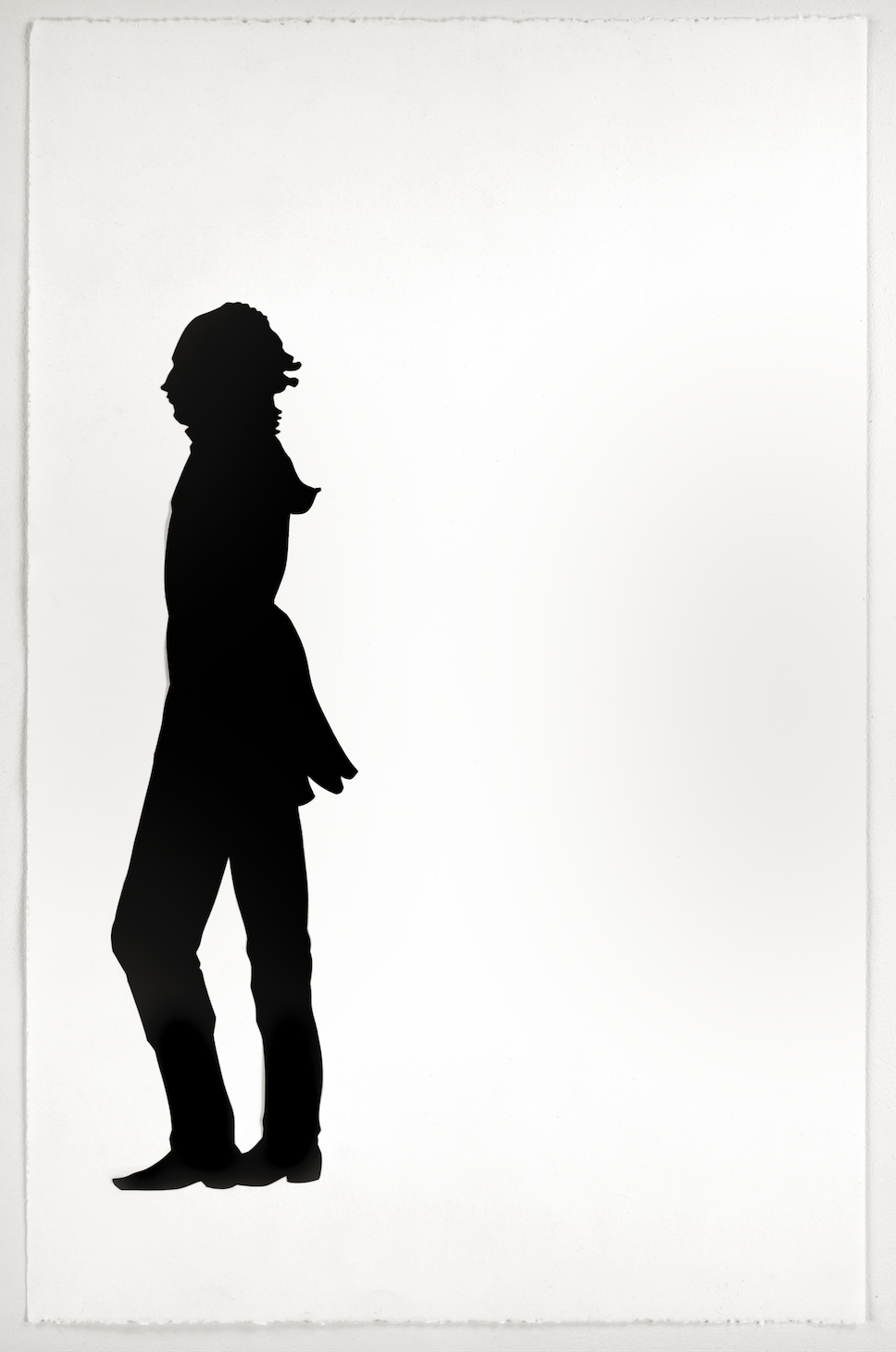
A key to appreciating how the substance of Walker’s figures activates the paradigm of the social sciences as well as that of bourgeois portraiture is contained in an Untitled paper cutout where on the left hand side we can see the profile of a European man and on the right hand side a female “primitive” seemingly standing back to back with him yet with no space separating them (Figure 3, above).[12] Walker shows the bourgeois portrait as materially inseparable and visually indistinguishable from the shadow archive of race science. The silhouette of the social sciences exists in a relationship of contiguity with bourgeois portraiture—indeed as its condition of possibility—as the literal version of what Allan Sekula has metaphorically described as the shadow archive of bourgeois photography, i.e. the police records and the eugenicist’s files. But while Sekula’s “shadow” indicates a hidden counterpart, an adversary and yet complementary—enabling—position, Walker’s archive evokes that and more. In her work the shadow is what sticks to the body as its inalienable Other. In this sense she provides a visual counterpart to Bhabha’s claim that, within the colonial framework, the representative figure of the Manichean delirium of black and white is the Enlightenment man tethered to the shadow of the colonized man.[13] At the same time, she shows how both traditions of the silhouette meet in the same blackness: the white normative body is always haunted by the remnants of the Other’s flesh, precisely because its abstraction is made possible by racial overembodiment.
Throughout her entire oeuvre, Walker’s work emphasizes the shadow’s inalienable contiguity to the body to which it belongs. Each of her figures, in other words, scandalously reveals its own archival position within the history of visuality, hence behaving not only as a visual object but also as a scene of constant reversibility between an indexical and an iconic order of signification as well as a theater of desire suspended between a fullness and a lack. It is in this sense that she recapitulates, by combining them, the two foundational paradigms for the ontology of the image within the visual arts: the shadow and the mirror. On the one hand, she invokes the Plinian tradition which understands images indexically—in contiguity with the real, as its cast shadows—and on the other hand, the Platonic tradition conceiving of images iconically, as purely apparent beings, linked to the real by their mirror-like resemblance. As Stoichita summarizes in his Brief History of the Shadow: “If, in the Plinian tradition, the image (shadow, painting, statue) is the other of the same, then in Plato the image (shadow, reflection, painting, statue) is the same in a copy state, the same is a state of double” (27).
What are Walker’s figures, then? Are they shadows or reflections? Are they Others or Doubles? And whose Other? Whose double? Their ambiguous indexical status (was/is a body there? and exactly where?) suggests how Walker’s work relentlessly pursues a status of both/and, which is also an in-betweenness, effectively engaging the cinema screen in an expanded and unflinching manner, as the meeting/arresting point between projection and reflection. This extension, and the way in which, in Walker’s silhouettes, we necessarily see ourselves seeing, constitute Walker’s second contribution to our understanding of the history of the cinema.
Her scenes, in fact, extend the cinematic screen by freezing it. Narrative temporality unfolds horizontally, within a fully comprehensive and unbroken space, frozen in a perpetually unfolding and continuous image. This layout, shared not only with pre-cinematic devices such as the panorama and diorama, but with landscape and historical painting as well,[14] presents itself as an alternative archive, a different indexing of history as a layered contemporaneity. Her purpose is to figure slavery not as a historical occurrence, but rather as, in Bill Brown’s words, a historical ontology.[15] “Too active to seem moribund, and too recognizable to be dismissed as safely part of the past,” Ann Wagner contends, Walker’s silhouettes “cross-breed past with present” (95). They function metahistorically, as haunting incarnations of racial templates. Not only do her figures act in the present—indexing a past that refuses to pass—but they also confront us directly, thus extending the cinematic screen durationally as well: they are uncompromisingly present and unapologetically in our presence.
There is no denying that we come to Walker’s combination of pre-cinematic viewing positions with a pre-photographic engagement with the relationship between the index and the icon, from the vantage point of a history of the photographic base of cinema that is reaching its conclusion. Walker’s metahistorical analysis—the use of archaic forms within a post-cinematic moment—offers provocative insights into the question of presence (not only the presence of the image, or the presence of the world in the image, but also our presence to the image) very much debated in the digital turn, particularly in relation to the survival or death of the index. Walker’s work intervenes in this conversation by asserting that part of the affective investment in indexicality is due to how it secures the observer’s location vis-a-vis the object of the gaze.[16] In order to expose the affective ontology of the index as a spatial theory of representation she creates images before which the viewer cannot claim to know his or her location. Images such as the Untitled gouache of Figure 4 (below) are unanchored because they exist on both sides of an implied photographic surface. Here the diegetic source of light is located behind the bodies. The figures on the left side of the image are white because rendered as cutouts, a void, within the thick darkness of the night. On the right side, however, the moonlight is partly blocked and partly filtering through the holes of this charred, lynched body, making clear that the corpse is present as a mass and positioned directly before the viewer. In this case, the silhouette effect is produced by overexposure, by how the body blocks the light thus placing us, at least for this half of the image, in an uncomfortable proximity with it. In this respect, I believe, Walker further qualifies what Barthes and Bazin value as photography’s ability to put us in the presence of something as a question of location.
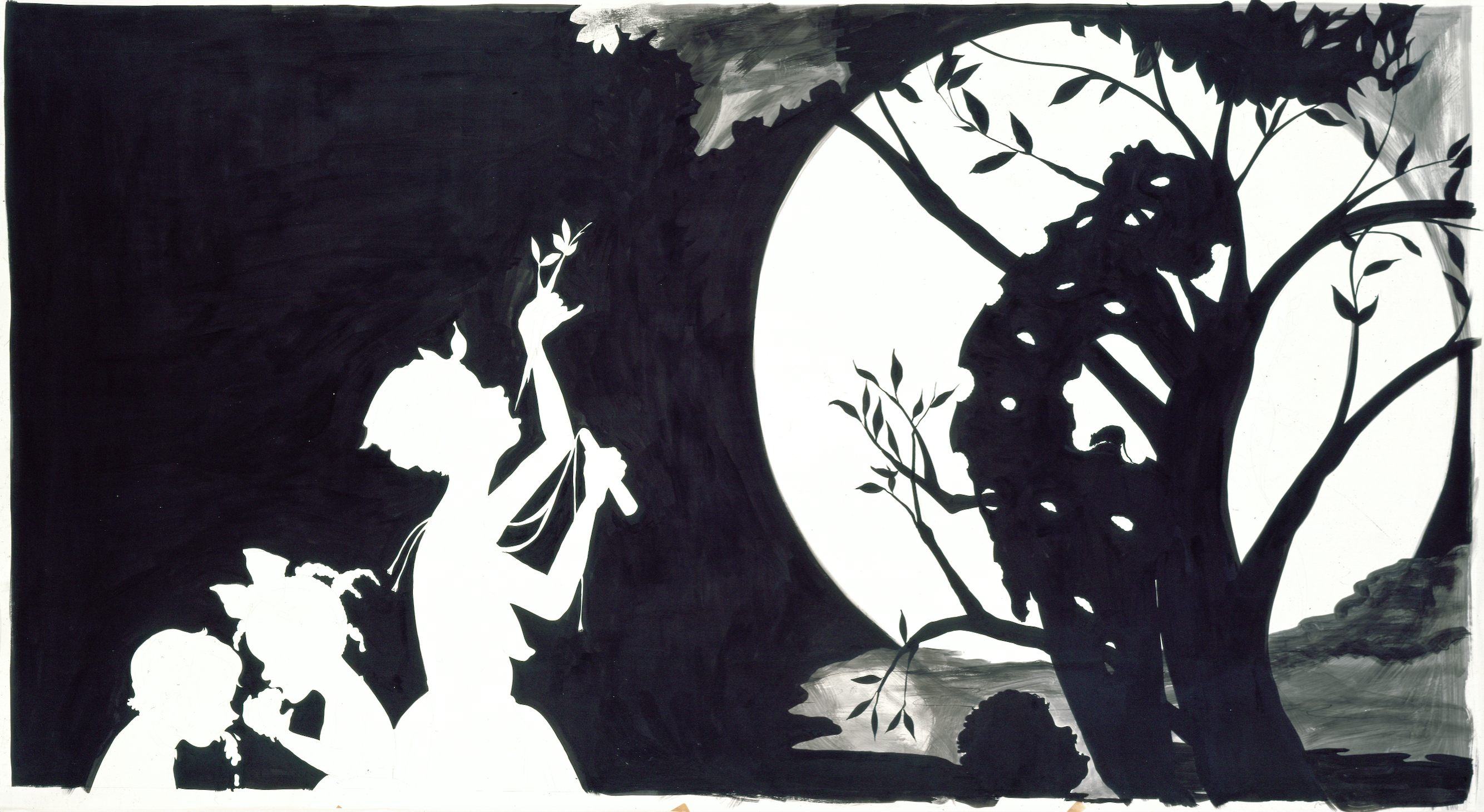
The ambiguity and reversibility of Walker’s figures and her experiments with both sides of the photographic surface establish a dialogue also with scholarship that highlights the permeability of the early cinema screen and its connection with other phenomenological discourses on the body as screen. In Atomic Light, for instance, Lippit argues that early cinema is but one of the three phenomenologies of the inside coming together in 1895, alongside X-ray photography and psychoanalysis. In distinctive and yet interconnected ways all three “figured” new and phantasmatic surfaces, producing images of three-dimensional flatness simultaneously cast and projected onto a screen.[17] Freud described both the ego and the body as surfaces upon which we are projected, and conceived of psychoanalysis as a search for depth beyond the surface of things. In the meantime, both the X-ray and the cinema introduced a mode of radical photography marked by a profound superficiality: X-ray photography flattens the inside and outside of the body into one common screen/surface turning the vantage point of the spectator-subject inside out, while the cinematic screen provides an impossible order of deep space, dramatized by a plethora of images in movement across the screen, such as arriving trains or receding subways. Cinema, according to Lippit, is a series of planes, which expand and contract in what Deleuze described as a metaphysical surface. As he further argues, the profound superficiality of these phenomenologies is possible because in psychoanalysis, X-ray photography, and the cinema, the skin and the screen are conflated onto each other: the skin acts as a surface of projection while the screen functions as a metonymy of skin. Both are permeable and transversable.
The black screen of early cinema is one of the sites of thematization of this permeability.[18] The black screen, Trond Lundemo maintains, is a technique that suspends the indexical basis of the photographic image in order to introduce an alternative to optical models of vision. Its function might be to conceal montage, or to elicit astonishment, or to open onto an abyss of deep space behind the surface of the image, or to punctuate a narrative change. Further, the blackness of the screen is a space of suspension and possible reversals. As Stephen Best points out in his analysis of What Happens in the Tunnel (Edwin S. Porter, 1903), it might also function as a scene of exchange. In this three-minute film set on a train car just a few years after the Plessy v. Ferguson decision that legalized segregation in the American South, a white woman traveling with her black maid is the target of a white man’s sexual advances. Suddenly, the train enters a tunnel, the screen fades to black and, as the screen image reappears on the other side of the tunnel, the man finds himself kissing the maid instead, who, taking advantage of the filmic and profilmic darkness, has exchanged places with her mistress. This black screen is thus a scene of multiple exchanges: between the two women, who have traded places in the train, between potential sexual partners (the joke of the film is that the man is shocked to discover he has kissed the maid instead of the white woman), between screen blackness and a void (the tunnel), between screen blackness and the maid’s epidermal blackness, between temporal and spatial ellipsis and a few seconds of cinematic emptiness. It thus signals a locus of reversibility bearing racial implications because of how the screen blackness is equated to the blackness of the substituted diegetic body.[19]
Like the black screen of early cinema, Walker’s figures act as portals towards a phantasmatic indexical source—the body that supposedly produced them—but also towards their “insides.” We slide in and out through these bodies, aware that while their blackness is a present sign of the body’s absence, it is also the sign of an overdetermined carnality. Like X-ray photographs, their blackness provides a view of the body simultaneously from the inside and out—from the space it has vacated and from its phenotype. Hence the sense of obscenity her installations provoke, which, I would like to suggest, does not so much derive from the actions that these figures are engaged in, but from the viewer’s realization of inhabiting a wholly and inescapably racialized space. The flatness of Walker’s figures is highly unstable, hard to pin to the gallery wall, precisely because they expand the cinema screen toward its inside, towards its impossible depth. “Casting their own shadows into an incalculable mise-en-abyme behind them,” argues Darby English in a similar vein, “these figures can seem to either threaten further advance into viewers’ space or retreat from their very points of appearance” (“This” 156).
The cinematic screen Walker evokes thus expands in two directions: toward its depth as well as outward, in a way that invades the space of the viewer. This effect is amplified and multiplied in her installations combining paper cutouts with projected light, where the viewers’ bodies are directly implicated by their own shadows cast onto the work (Figure 5, below). These installations heighten the theater of gazes—viewers looking at the work and looking at each other looking—by engineering a way to project onto the work a trace, however fleeting, of those very looks. That trace, the viewer’s cast shadow onto the gallery wall, once again calls into question the “substance” of her figures by equalizing it with the viewer’s.
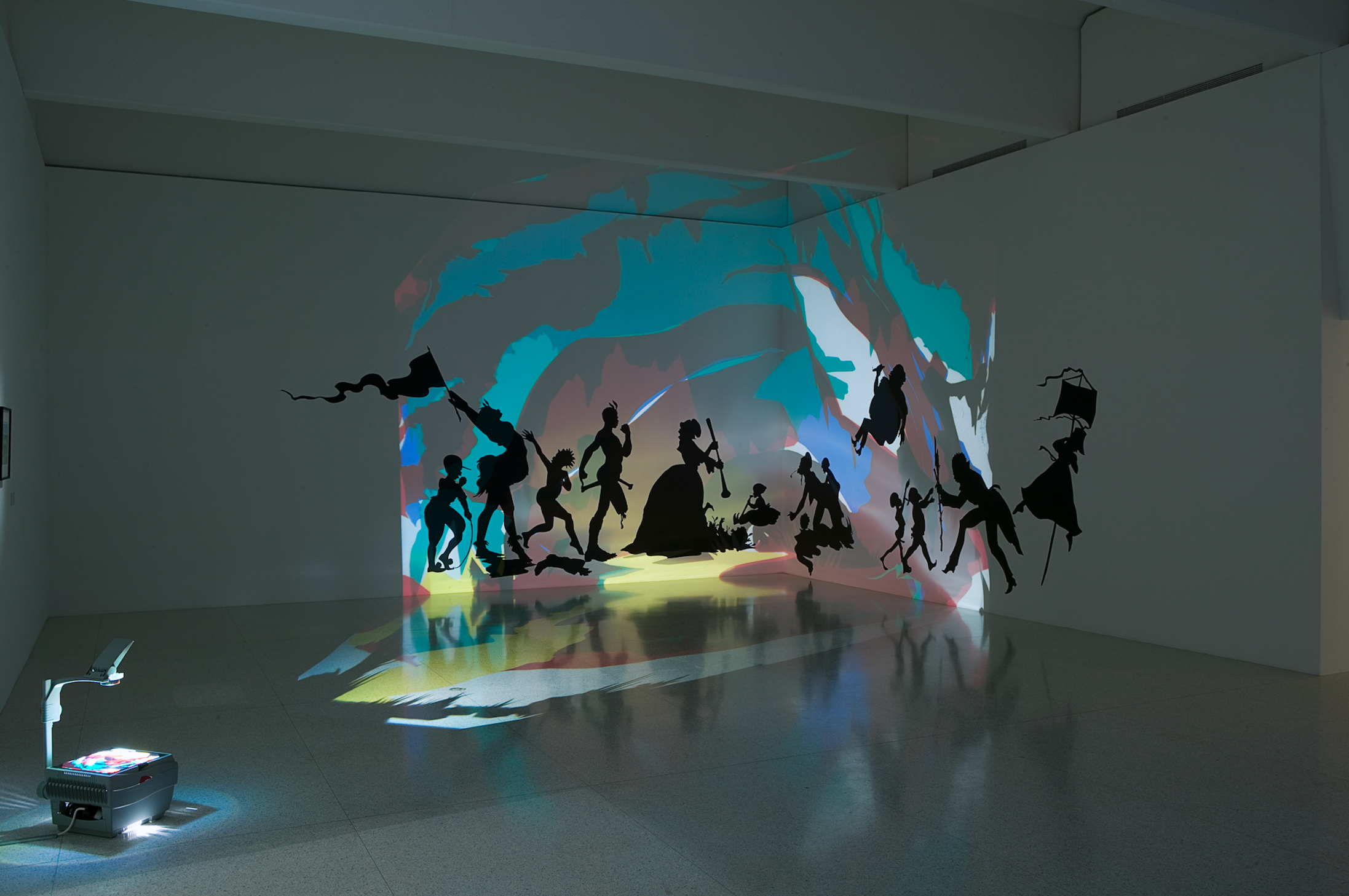
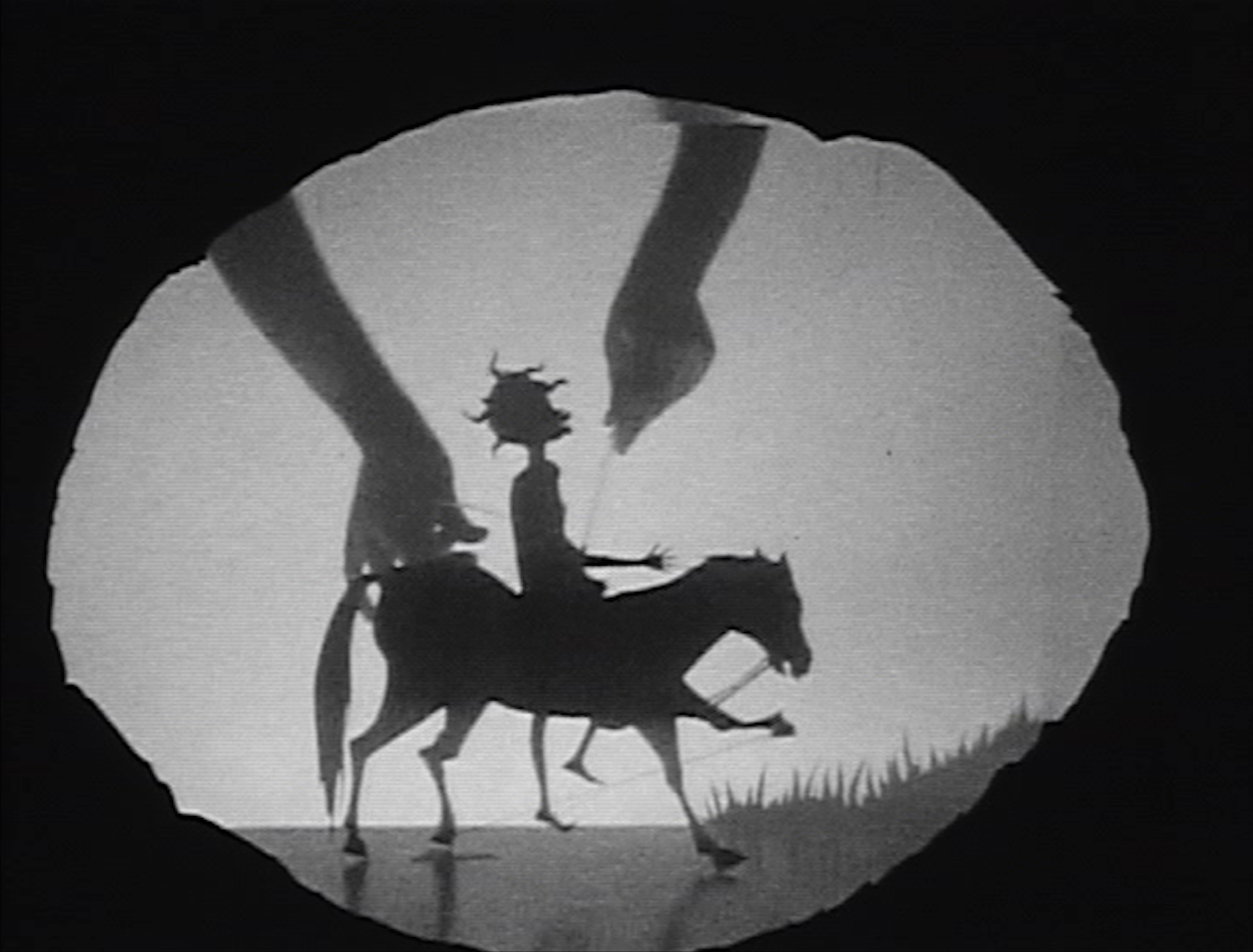
This sense of double movement is further heightened in Walker’s stop-motion puppetry videos that she sometimes mounts alongside “still” installations (Figure 6, above). Here the question of presence carries other connotations: not only the foregrounding of the artist’s presence by letting her hand appear within the frame while maneuvering her cutouts within a deep space, but also its relationship to cinematic movement and duration. Here the viewer is confronted with the fact that the moving image is obtained by a succession of discrete durational wholes so that, as Jennifer Barker puts it, animation offers “a lingering look at an extended arrest of movement” (136). Furthermore, the puppets are so flat, so flimsy, and their movements so awkward that they appear as shadows severed from their bodies, running amok—possibly, as Robert Storr suggests, to further underline their status as product of a hysterical white imagination spooked by its own shadow, “by the shadow it conjured out of the presence in its midst of what it mistook for its God-given antithesis” (65). Lest we forget these shadows’ displaced connections to living bodies, in a by now expected twist, these ghostlike creatures reclaim their carnality and ejaculate towards the viewer and against the screen. The thickness and liveliness of the flesh that Walker’s figures initially appeared to have had fully abstracted here return as bodily fluid traveling through space, connecting, once again, not only the space of the work with the space of the viewer, but the (wet) skin with the (wet) screen.
The fact that, throughout Walker’s work, blackness is the meeting point between the screen and the skin suggests that the structural asymmetry between the inside and outside of the body in the last instance reflects the structural asymmetry of race.[20] As we debate the question of presence in the digital image, the survival or death of the index, and other ways to determine whether the digital severs the Barthesian umbilical cord and is fully—and for some people, hopelessly—simulacral, Kara Walker inhabits this post-cinematic moment by demanding that we remember the epistemology of the visual surface that still informs its phenomenology. Background and foreground, positive and negative, mass and space, inside and outside, fullness and void, presence and absence: the relationship between these poles still depends on the interaction between blackness and whiteness, as conditions of legibility of images as such. But unequal ones. Blackness, in fact, is always susceptible of being a signifier of depth as well as of surface—the surface of some-body. By highlighting the phenotype as a screen of projection and reflection, Walker identifies the epidermality of race as a hermeneutic of the surface that predates and supports those developed in the late 19th century. If, as Storr asks, “in the Eurocentric tradition blackness has historically been the shadow that whiteness casts, what is the shadow of blackness? . . . —A black hole at the core of Western culture?” (65). Ultimately the black body—black inside and out—emerges as the visual object par excellence, where the shadow meets its substance: the black body as the sign of the visible, the visible turned into a sign.
Works Cited
Auerbach, Jonathan. Body Shots: Early Cinema Incarnations. Berkeley: U of California P, 2007. Print.
Barker, Jennifer M. The Tactile Eye: Touch and the Cinematic Experience. Berkeley: U of California P, 2009. Print.
Beckman, Karen, and Jean Ma, eds. Still Moving: Between Cinema and Photography. Durham: Duke UP, 2008. Print.
Bellour, Raymond. “Concerning the Photographic.” Beckman and Ma 253-76.
Berry, Ian, Darby English, Vivian Patterson, and Mark Reinhardt, eds. Kara Walker: Narratives of A Negress. New York: Rizzoli, 2007. Print.
Best, Stephen. The Fugitive’s Properties. Law and the Poetics of Possession. Chicago: U of Chicago P, 2004. Print.
Bhabha, Homi. “The Other Question: Stereotype, Discrimination and the Discourse of Colonialism.” The Location of Culture. New York: Routledge, 1994. 94-120. Print.
—. “Remembering Fanon: Self, Psyche, and the Colonial Condition.” Rethinking Fanon: The Continuing Dialogue. Ed. Nigel Gibson. New York: Humanity, 1999. 179-96. Print.
Bowles, John P. “Blinded by the White: Art and History at the Limits of Whiteness.” Art Journal 60.4 (2001): 39-43. Print.
Brown, Bill. “Reification, Reanimation, and the American Uncanny.” Critical Inquiry 32 (2006): 175-207. Print.
Burch, Noel. Life to Those Shadows. Berkeley: U of California P, 1990. Print.
Derrida, Jacques. The Work of Mourning. Chicago: U of Chicago P, 2001. Print.
Doane, Mary Ann. The Emergence of Cinematic Time. Modernity, Contingency, the Archive. Cambridge: Harvard UP, 2002. Print.
Doane, Mary Ann, ed. Indexicality: Trace and Sign. Spec. issue of Differences 18.1 (2007). Print.
English, Darby. How to See a Work of Art in Total Darkness. Cambridge: MIT P, 2007. Print.
—. “This is Not About the Past: Silhouettes in the Work of Kara Walker.” Berry et al. 141-67.
Fusco, Coco, and Brian Wallis, eds. Only Skin Deep. Changing Visions of the American Self. New York: International Center of Photography-Harry Abrams, 2003. Print.
Gaines, Jane. Fire and Desire: Mixed-Race Movies in the Silent Era. Chicago: U of Chicago P, 2001. Print.
Krauss, Rosalind. “Notes on the Index: Seventies Art in America.” October 3 (1977): 68-81. Print.
Lippit, Akira M. Atomic Light (Shadow Optics). Minneapolis: U of Minnesota P, 2005. Print.
Lundemo, Trond. “The Colors of Haptic Space: Black, Blue, and White in Moving Images.” Color: The Film Reader. Eds. Angela Dalle Vacche and Brian Price. New York: Routledge, 2006. Print.
Lyon, John B. “The Science of Sciences: Replication and Reproduction in Lavater’s Physiognomics.” Eighteenth-Century Studies 40.2 (2007): 257-77. Print.
Mirzoeff, Nicholas. “The Shadow and the Substance: Race, Photography, and the Index.” Fusco and Wallis 111-28.
Mitchell, W.J.T. What Do Pictures Want? The Lives and Loves of Images. Chicago: U of Chicago P, 2005. Print.
Pindell, Howardena. Kara Walker-No, Kara Walker-Yes, Kara Walker-? New York: Midmarch Arts Press, 2009. Print.
Reid-Pharr, Robert, Annette Dixon, and Thelma Golden, eds. Kara Walker: Pictures From Another Time, Ann Arbor: U of Michigan Museum of Art-D.A.P., 2002. Print.
Reinhardt, Mark. “The Art of Racial Profiling.” Berry et al. 108-29.
Robinson, Amy. “Forms of Appearance of Value: Homer Plessy and the Politics of Privacy.” Performance and Cultural Politics. Ed. Elin Diamond. London: Routledge, 1996. 237-61. Print.
Rodowick, David. The Virtual Life of Film. Cambridge: Harvard UP, 2007. Print.
Schwartz, Louis-Georges. “Cinema and the Meaning of ‘Life.’” Discourse 28.2-3 (2008): 7-27. Print.
Sekula, Alan. “The Body and the Archive.” October 39 (1986): 3-64. Print.
Shaw, G. DuBois. Seeing the Unspeakable: The Art of Kara Walker. Durham: Duke UP, 2004. Print.
Smith, Shawn Michelle. Photography on the Color Line: Du Bois, Race, and Visual Culture. Durham: Duke UP, 2004. Print.
Sontag, Susan. On Photography. New York: St. Martin’s, 1977. Print.
—. Regarding the Pain of Others. New York: St. Martin’s, 2003. Print.
Stoichita, Victor. A Short History of the Shadow. London: Reaktion, 1997. Print.
Storr, Robert. “Spooked.” Vergne et al. 63-74.
Vergne, Philippe, Sander L. Gilman, Thomas McEvilley, Robert Storr, Kevin Young, and Yasmin Raymond, eds. Kara Walker: My Complement, My Enemy, My Oppressor, My Love. Minneapolis: Walker Art Center, 2007. Print.
Wagner, Anne M. “Kara Walker: The Black-White Relation.” Berry et al. 90-101.
This chapter was first published under the same title in The Very Beginning/At the Very End. Eds. Jane Gaines, Francesco Casetti, and Valentine Re. Udine: Forum, 2010. 211-20. An expanded version appears also in Alessandra Raengo, On the Sleeve of the Visual: Race as Face Value (Dartmouth College Press, 2013). Reprinted with permission from Forum Editrice Universitaria Udinese. Artwork ©Kara Walker, courtesy of Sikkema Jenkins & Co., New York.
[1] Even though it refers to Noel Burch’s work on early cinema, Life to Those Shadows, the title of this essay intends to locate Walker’s work within contemporary scholarship that addresses the relevance of the “photographic” as a critical/historical paradigm. An excellent overview of this position is offered in Beckman and Ma, especially Raymond Bellour’s essay “Concerning the Photographic.” His characterization of contemporary installation art addressing the relationship between photography and cinema as revealing multiple image-states is particularly descriptive of the “life” that animates Kara Walker’s silhouettes, i.e. the very “wildly fluctuating, moving discontinuity” of mental images, situated “between photography’s somewhat too-complete fixity and cinema’s often too-calm illusion of movement” (Bellour 270). Part of the perceived “obscenity” of Walker’s work, I argue in the remainder of the chapter, comes from having brought to life images that had been safely confined to the landscape of the mind.
[2] The controversy was initiated by Betye Saar and Howardena Pindell who, on the occasion of Walker’s receipt of the McArthur Foundation “Genius Grant” at age 27, accused her of producing images hurtful to the black community and called for a boycott of her work. It is summarized in Shaw and Pindell. The main publications on Walker’s work are Reid-Pharr et al., Vergne et al., and Berry et al.
[3] Stereotypes are indeed crucial to Walker’s work, but in the sense Homi Bhabha understands them: as scenes of desire, rather than inadequate, offensive, or misleading representations. The stereotype, argues Bhabha, is not the object of desire, but its setting; it is not an ascription of a priori identities, but rather their production (“Other”). More to the point, it operates like a fetish: it is a scene of subject formation. It responds to multiple desires that are also mobilized by Walker’s installations: to make present, to make visible, to make knowable, and to fixate.
[4] John P. Bowles, for instance, argues:
The debate surrounding her art demonstrates the difficulty we have with work that implicates viewers in the perpetuation of whiteness’s claim to privilege. Walker creates quasi-cinematic scenes in which perpetrators are the victims of their own fantasies. . . . Her figures are apparitions who resemble the normative white subject but who are instead difference itself made manifest. They represent, on some level, who white viewers fear they might be. . . . They seem credible but are fantasy, and they are too horrible to be real. (39).
[5] Discussion of controversial work such as Walker’s necessarily raises ethical questions: the charge of obscenity, in fact, expresses moral concerns with the propriety, efficacy, and ownership of a certain racial imagery, which are made all the more acute by the extraordinary success she has had with white collectors. The impossibility to determine the proper affective response to her work (pain, pleasure, shock, outrage, and so on), in fact, importantly foregrounds how such affects carry different ethical repercussions along racial lines. Even though extremely important, these issues are beyond the scope of this paper, which instead addresses what this controversy has often distracted scholars from: that Walker’s work offers a theory of the visual in which race is not simply a specific content but rather a foundational epistemology.
[6] I draw here on a broad and transhistorical notion of the photographic as an operative model constructed around stillness and movement on the one hand, and indexicality and iconicity on the other, as espoused, among others, by Susan Sontag in On Photography and Regarding the Pain of Others; Krauss; Bellour; and Doane. Two fundamental texts on the relationship between race and the photographic are Smith, and Fusco and Wallis.
[7] For an account of this myth, see Stoichita. This myth has been influentially evoked in relation to the “desire” of images by Mitchell.
[8] On the isomorphism between fetish and stereotype see Bhabha, “Other.”
[9] The transition between the indexical and the iconic function, as Stoichita points out, required that the shadow assume the symbolic form of the profile. This, he claims, “was in fact the only message that the myth of origins of art was understood to convey, because it maintained that only in the profile of the outlined shadow could mimesis and index (likeness and physical connection) coexist” (11). This is important because Lavater’s hermeneutic project, as Lyon indicates, hinged on the confusion between an indexical and iconic paradigm of the visual.
[10] Another crucial transition between an indexical to an iconic order of signification occurs here: because black is the sign of the silhouette’s likeness to the body it indexes, it becomes the “face” of the index as well. Black becomes the signifier of likeness, of resemblance as a visual regime: not just an iconic sign, but the signifier of the iconic. Robinson has been instrumental to my thinking in this respect.
[11] For a discussion of Walker’s critical engagement with the paradigm of the social sciences, see Reinhardt. For the categorical notion of the index, see Mirzoeff.
[12] “Primitive” is one of the terms Walker uses to evoke a female persona, which she sometimes adopts for herself, to underscore the expectations of patronage, modeled after Josephine Baker’s exotic sauvage.
[13] The self-representation of the colonial man, argues Bhabha, depends upon a staged division between body and soul that underlies the artifice of identity. The native occupies the carnal pole while the Westerner occupies the spiritual one. The tethered shadow of the colonized man offers “the ‘Otherness’ of the Self inscribed in the perverse palimpsest of colonial identity” (Bhabha, “Remembering” 186).
[14] Darby English specifically addresses the relationship to landscape painting.
[15] See also Shaw for an expanded discussion of Brown’s description of Walker’s work as a “rememory of slavery.”
[16] In David Rodowick’s terms, Walker’s silhouettes extend the ontological perplexity of photography along the temporal axis (i.e. that things absent in time can be present in space) to the spatial axis. Her figures double the paradox of temporal perception of photography with the paradox of spatial recognition of optical illusions such as the duck-rabbit figure: how can they both be there in the same space?
[17] Furthermore, cinema, X-ray photography, and psychoanalysis transformed the structure of visual perception from phenomenal to phantasmatic, from perceived to imagined visuality, from visual to avisual, and in so doing, constituted another shadow archive to be placed alongside the one identified by Sekula: the avisual archive of a new phantasmatic visuality. “What constitutes, defines, determines the thereness of the X-ray?” asks Lippit, “[w]hat is there in the X-ray, depth or surface, inside or out? What is there to be seen? A thereness, perhaps, that is avisual: a secret surface between the inside and out.” (52). I thank Jennifer M. Barker for introducing me to Lippit’s work.
[18] See Auerbach, especially the reference to Marey’s practice of dressing people in black to emphasize the recording of movement. See also Doane’s Emergence.
[19] For Best, this exchange abides by the logic of the counterfactual as a form of legal argumentation and historical causation that produces a mirror-like imaginary inverted equivalent of the actual world. The duck-rabbit of Walker’s silhouettes can be said to invoke similar stakes. See also Gaines.
[20] Shawn Michelle Smith develops some of these insights in relation to W.E.B. DuBois’s notion of double-consciousness and especially the Veil, understood as theories of visuality. DuBois described double-consciousness as the awareness of being seen through the eyes of another and the Veil as a coat of opacity that shrouds the black subject into invisibility but also as two-sided screen: as it makes the Black opaque, it also affords her the possibility to look back while remaining unseen.
Alessandra Raengo is Associate Professor of Moving Image Studies in the Department of Communication at Georgia State University and coordinator of liquid blackness, a research project on blackness and aesthetics. Her work focuses on blackness in the visual and aesthetic field and her essays on contemporary African-American art, black cinema and visual culture, and race and capital have appeared or are forthcoming in Camera Obscura, Adaptation, The World Picture Journal, Discourse, and several anthologies. She is the author of On the Sleeve of the Visual: Race as Face Value (Dartmouth College Press, 2013) and Critical Race Theory and Bamboozled (Bloomsbury, 2016). With Robert Stam, she has also co-edited two anthologies on adaptation studies, Literature and Film and A Companion to Literature and Film (Blackwell, 2004 and 2005).
Alessandra Raengo, “Life in Those Shadows! Kara Walker’s Post-Cinematic Silhouettes,” in Denson and Leyda (eds), Post-Cinema: Theorizing 21st-Century Film (Falmer: REFRAME Books, 2016). Web. <https://reframe.sussex.ac.uk/post-cinema/5-5-raengo/>. ISBN 978-0-9931996-2-2 (online)
